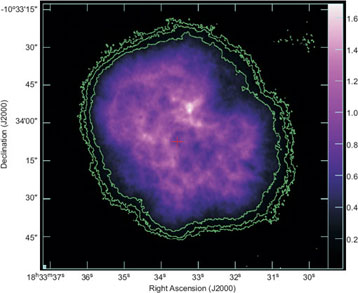The Expansion of Supernova Remnant G21.5–0.9:
Is PSR J1833–1034 the Youngest Pulsar?
The supernova remnant G21.5–0.9 (SNR 021.5–00.9) has been known for over 30 years and has long been classified as a filled-center or a Crab-like remnant (e.g., Wilson & Weiler 1976). Such supernova remnants are powered by a central pulsar rather than by the interaction of the expanding ejecta shell with its surroundings. This is known as a “pulsar wind nebula” or PWN, with the Crab Nebula generally being regarded as the prototype. G21.5–0.9 is a bright, centrally condensed radio and X-ray source, with a diameter of ~1", although in the X-ray, a larger, low surface brightness halo is also seen (Bocchino et al. 2005; Matheson & Safi-Harb 2005). The distance to G21.5–0.9 is ~5 kpc (Camilo et al. 2006). G21.5–0.9’s radio and X-ray luminosities are ~10 percent and ~1 percent of those, respectively, of the Crab Nebula.
Although G21.5–0.9 had been identified as a PWN, no pulsar had been seen until recently, when two teams announced the discovery of PSR J1833–1034 (Gupta et al. 2005; Camilo et al. 2006), with a period of 61.8 ms. Although the pulsar is quite faint (~70 μJy at 1.4 GHz), it is slowing down rapidly, and has a spindown energy loss of ~3.3×1037 erg s-1, which, in our Galaxy, is second only to that of the Crab pulsar.
The characteristic age of the pulsar is 4800 yr. However, the characteristic ages are often very inaccurate measures of pulsars’ true ages, and no other direct age measurements were so far available for PSR J1833–1034 or G21.5–0.9. The latter’s relatively small size and other arguments had led several authors to suggest a notably younger true age of ~1000 yr (e.g., Bocchino et al. 2005; Camilo et al. 2006).
We obtained a new, high-resolution image of G21.5–0.9 in 2006 using the NRAO VLA at 5 GHz in the A and B array configurations. We also used some Dconfiguration data from the VLA archive to better recover the large-scale structure of the nebula (see Bietenholz & Bartel 2008).

Figure 1. A radio image of G21.5–0.9 at 4.75 GHz from 2006. Maximum entropy deconvolution was used. The FWHM of the elliptical Gaussian restoring beam was 0.82 × 0.53" at p.a. 10 degrees. The peak brightness was 1.69 mJy bm-1 and the rms background brightness was 19 μJy bm-1. Contours are drawn at 4, 8, and 16 percent of the peak brightness. The red cross marks the position of the pulsar, taken from Camilo et al. (2006), and known to an accuracy of < 0.5". Filamentary structure can be seen throughout the nebula.
We show our image of G21.5–0.9 in Figure 1. Prominent filamentary structure is seen, reminiscent of that seen in radio images of the Crab Nebula and 3C 58. Such filamentary structure seems to be a common feature of PWNe. The remnant has a double-lobed structure, with the axis of symmetry running approximately from the northwest to the southeast, similar to the structure seen in the X-ray. Unlike in the X-ray, however, there is no bright central condensation in the radio, and the northwest lobe is somewhat brighter than the southeast one.
We also re-imaged archival VLA data from 1991 (Frail & Moffett 1993) to produce a 1.5 GHz image. By comparing the two images, taken almost 15 years apart, we determined the expansion speed of the nebula. We also determined the spectral index, which is quite uniform over the nebula, as is typical of PWNe. (For details of how the spectral index and temporal evolution were disentangled, see Bietenholz & Bartel 2008).
G21.5–0.9 has expanded by 1.7±0.3 percent over the 14.8 yr period between the two images. At 5 kpc, this corresponds to an expansion speed of 910±160 km s-1 with respect to the center of the nebula. Assuming undecelerated expansion, this speed implies that the age of G21.5–0.9, and thus also of PSR J1833–1034, is 870+200 –150 yr, dramatically confirming earlier suggestions of a young age. This age makes PSR J1833–1034 and G21.5–0.9 one of the youngest known pulsars and PWNe. Although the expansion age is a far more reliable estimate of the true age than the pulsar’s characteristic age, it is likely a slight underestimate. Since the PWN is expanding not within a stationary medium, but within the more rapidly expanding supernova ejecta, the pulsar’s energy input will cause a small acceleration, making the true age slightly less than our expansion age. The Crab Nebula’s true age is known, as it is associated with a recorded supernova in 1054 AD, and its expansion age is ~800 yr.
In other words, our measurement suggests that G21.5–0.9 and the Crab Nebula likely have similar true ages of ~1000 yr. We note that the hydrogen column density and visual extinction (10–11 mag) implied by the X-ray measurements makes it unlikely that the supernova event would have been noticed.
G21.5–0.9 and PSR J1833–1034 thus take their place among the youngest pulsars and pulsar-wind nebulae in the galaxy. Future observations may allow us to measure the acceleration, and thus directly measure the dynamics of a pulsar-wind nebula expanding into the shell of supernova ejecta.
M. F. Bietenholz (Hartebeesthoek Radio Observatory, York University)
References:
Bietenholz, M. F., & Bartel, N. 2008, ArXiv e-prints, 0802.0152
Bocchino, F., van der Swaluw, E., Chevalier, R., &
Bandiera, R. 2005, A&A, 442, 539
Camilo, F., Ransom, S. M., Gaensler, B. M.,
Slane, P. O., Lorimer, D. R., Reynolds, J.,
Manchester, R. N., & Murray, S. S. 2006, ApJ,
637, 456
Frail, D. A., & Moffett, D. A. 1993, ApJ, 408, 637
Gupta, Y., Mitra, D., Green, D. A., & Acharyya, A.
2005, Current Science, 89, 853
Matheson, H., & Safi-Harb, S. 2005, Advances in
Space Research, 35, 1099
Wilson, A. S., & Weiler, K. W. 1976, A&A, 49, 357
|

